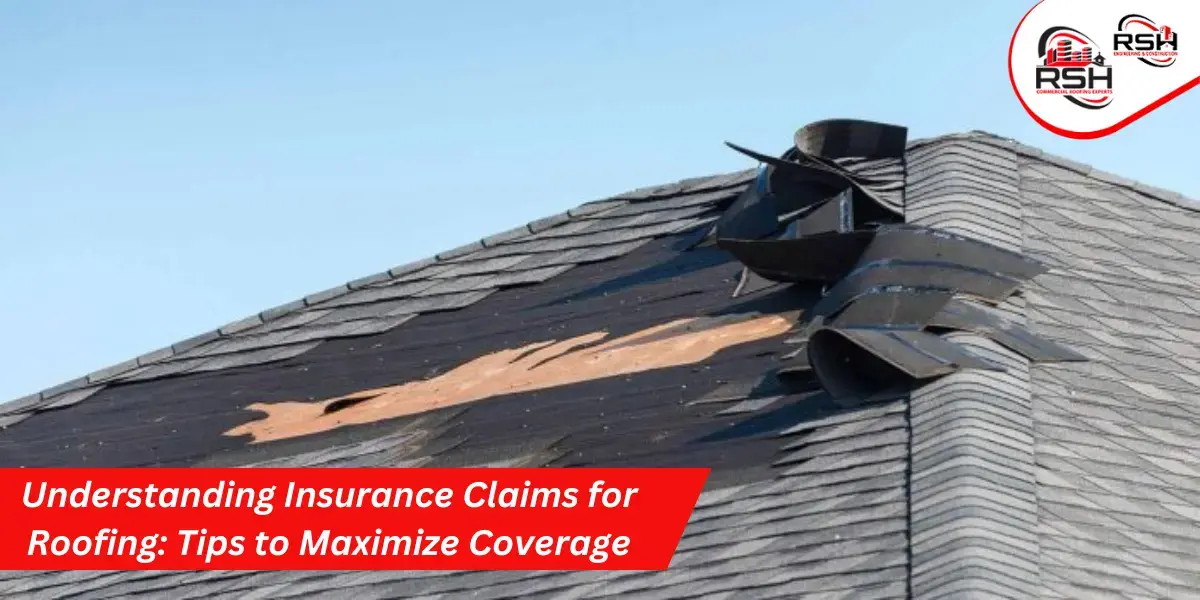RSH Commercial Roofing is a Professional Engineering & Construction Company with 25+ years of experience that specializes in Commercial & Residential Roof Inspections, Repair/Replacement services as well as commercial roofing insurance claims.

Understanding Insurance Claims for Roofing: Tips to Maximize Coverage
A damaged roof can be one of the most stressful experiences for homeowners, especially when faced with the prospect of repairs or replacements. Luckily, insurance claims for roofing can help ease the financial burden. However, navigating the roof insurance claim process can be complex, particularly after storms or other natural disasters.
In this submission, you’ll learn everything you need about roofing insurance claims, how to maximize your coverage, and tips for working with roof repair services and contractors to restore your roof efficiently. Let’s understand!
What Are Roofing Insurance Claims?
A roof insurance claim is a request submitted to your homeowner’s insurance company to cover repairing or replacing a damaged roof. Insurance policies typically cover unexpected damages, such as those caused by storms, hail, or falling debris, but don’t include general wear and tear or poor maintenance.
Types of Roof Damage Covered by Insurance
Understanding what your policy covers is vital to a smooth insurance claims for roofing process. Most insurance policies cover:
1. Storm Damage Roof Insurance Claims
- Severe winds, heavy rain, or hurricanes can storm damage roof insurance claims, flashing, or roof structures.
2. Hail Damage Insurance Claims
- Hail can cause dents, cracks, or leaks in your roof. This is one of the most common claims in regions prone to hailstorms.
3. Falling Debris
- Insurance may cover roof damage caused by falling trees or branches after storms.
4. Fire Damage
- Insurance will likely help with repair or replacement costs if your roof sustains fire damage.
Steps in the Roof Insurance Claim Process
Filing a roof damage insurance claim doesn’t have to be daunting. Here’s a step-by-step guide to help you navigate the process:
1. Assess the Damage
After a storm or incident, inspect your roof for visible damage, such as missing shingles, leaks, or dents. Take pictures or videos to document the damage.
2. Review Your Insurance Policy
Understand what your policy covers. Some policies may have exclusions or limits for certain types of damage.
3. Contact Your Insurance Provider
Notify your insurance company immediately. Delayed reporting can result in your claim being denied.
4. Work with a Roofing Contractor
Hire professional roof contractors to inspect the damage thoroughly. They can provide a detailed report and cost estimate, strengthening your case.
5. Meet with the Insurance Adjuster
The insurance company will send an adjuster to evaluate the damage. Ensure that your roofing contractor is present during this inspection to advocate on your behalf.
6. File the Claim
Submit all necessary documentation, including the contractor’s report, damage photos, and repair invoices.
7. Receive Approval and Repairs
Once your insurance claims for roofing is approved, work with reliable repair services to promptly restore or replace your roof.
Tips to Maximize Your Roofing Insurance Claim
1. Document Everything
Take clear, dated photos of your roof before and after the damage to show the extent of the issue. This can significantly help during the claims process.
2. Work with Experience Roof Contractors
A professional contractor can accurately assess the damage, provide a detailed estimate, and assist in communicating with your insurer.
3. Understand Policy Exclusion
Some policies don’t cover damage due to poor maintenance or an aging roof. Make sure your roof is in good condition before any incident occurs.
4. Act Quickly
Delaying repairs or filling your roof insurance claim can lead to further damage and possible denial of coverage.
5. Be Persistent
If your insurance claims for roofing is denied, don’t hesitate to appeal. Provide additional documentation or hire an independent adjuster to reassess the damage.
Roof Repair or Replacement?
One common question homeowners face is whether to repair or replace their roof after damage. The answer depends on the severity of the damage and the roof’s age.
● Roof Repair Services:
It is ideal for minor issues like missing shingles, small leaks, or localized damage.
● Roof Replacement:
It is necessary for extensive damage, especially if the roof is near the end of its lifespan (typically 20-30 years for asphalt shingles).
Your insurance company will determine if a repair or replacement is warranted based on their assessment.
FAQs About Roofing Insurance Claims
Q1: What is the average timeline for a roof insurance claim?
A1: The process can take anywhere from a few weeks to a couple of months, depending on the severity of the damage and the insurance company’s procedures.
Q2: Can I file a claim for an old roof?
A2: Insurance usually doesn’t cover wear and tear or age-related damage. However, if a storm causes damage, you may still be eligible for a claim.
Q3: Do I need to pay for roof repairs upfront?
A3: Most insurance policies require a deductible before covering the remaining costs. Some contractors may offer financing options for the upfront cost.
Conclusions
Navigating insurance claims for roofing doesn’t have to be a headache. By understanding your policy, acting quickly, and working with trusted roof contractors, you can maximize your coverage and restore your roof with minimal stress. Whether dealing with hail damage insurance, a roof replacement, or minor repairs, staying informed and proactive is critical to a successful outcome.
For all your roof repair services, choose reliable contractors who can guide you through the roof insurance claim process and deliver quality work. A sale and sturdy roof is vital for protecting your home and family—so don’t hesitate to take the necessary steps with RSH Roof & Construction Services to ensure yours is in the best condition.

